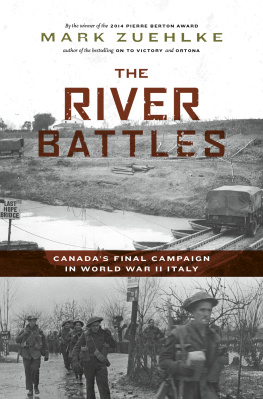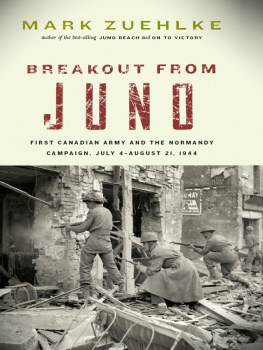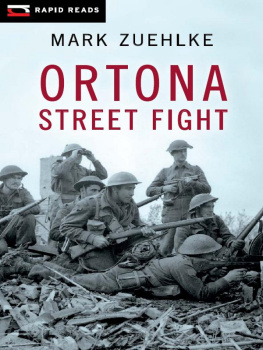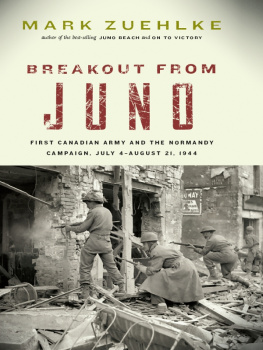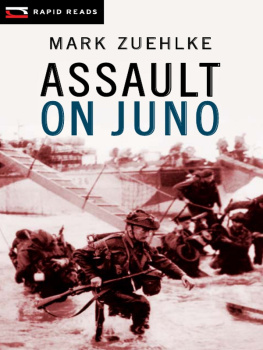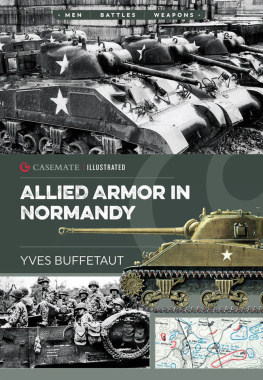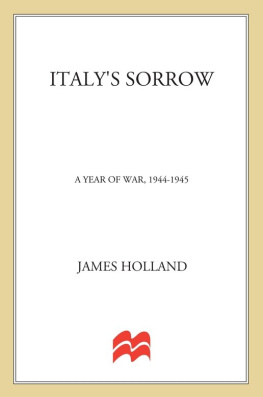The Gothic Line
THE GOTHIC LINE
CANADAS MONTH OF HELL IN WORLD WAR II ITALY
MARK ZUEHLKE

Copyright 2003 by Mark Zuehlke
03 04 05 06 07 5 4 3 2 1
All rights reserved. No part of this book may be reproduced, stored
in a retrieval system or transmitted, in any form or by any means,
without the prior written consent of the publisher or a licence from
The Canadian Copyright Licensing Agency (Access Copyright). For
a copyright licence, visit www.accesscopyright.ca or call toll free
to 1-800-893-5777.
Douglas & McIntyre Ltd.
2323 Quebec Street, Suite 201
Vancouver, British Columbia
Canada V5T 4S7
www.douglas-mcintyre.com
National Library of Canada Cataloguing in Publication Data
Zuehlke, Mark
The Gothic Line : Canadas month of hell in World War II Italy / by Mark Zuehlke.
Includes bibliographical references and index.
ISBN 1-55365-023-9
1. World War, 19391945CampaignsItaly. 2. Canada.
Canadian ArmyHistoryWorld War, 19391945. I. Title.
D763.I8Z83 2003 940.54215 C2003-910595-4
Library of Congress information is available upon request
Editing by Elizabeth McLean
Jacket design by Peter Cocking & Jessica
Sullivan Jacket photograph: NAC PA-173437
Interior design by Peter Cocking
Maps by C. Stuart Daniel/Starshell Maps
Typeset by Rhonda Ganz
Printed and bound in Canada by Friesens
Printed on acid-free paper
All photos were supplied by the National Archives of Canada,
and, unless cited, were taken by unspecified Department of
National Defence photographers.
We gratefully acknowledge the financial support of the Canada
Council for the Arts, the British Columbia Arts Council, and the
Government of Canada through the Book Publishing Industry
Development Program (BPIDP) for our publishing activities.
It is just a rough hard job, which must be carried through.
WINSTON CHURCHILL
Oh, what with the wounded, and what with the dead.
And what with the boys, who are swinging the lead.
If this war isnt over, and that goddamn soon,
Therell be nobody left in this bloody platoon.
UNKNOWN CANADIAN SOLDIER IN ITALY
I cant see us getting out of here alive.
PRIVATE STAN SCISLOWSKI,
PERTH REGIMENT OF CANADA
[ CONTENTS ]
PREFACE
THIS IS THE FINAL VOLUME of what has developed into a trilogy of books detailing the experiences of Canadians in the largest, most decisive battles of World War IIs Italian campaign. Following the publication of both Ortona: Canadas Epic World War II Battle and The Liri Valley: Canadas World War II Breakthrough to Rome, an ever growing number of veterans of this long, brutal, and terribly costly campaign contacted me to share their personal memories of the Gothic Line Battle. I have drawn on veteran memories by letter, E-mail correspondence, telephone calls, and personal interviews. The willingness of these old soldiers to frankly discuss what for many was a painfully grim part of their young lives has made these three books possible. It is their ability to vividly recall many detailssifted together with the official records, regimental diaries and official histories, autobiographies and biographies, and other archival materialsthat enabled a dramatic and detailed depiction of the combat experience of Canadians at the Gothic Line during the late summer of 1944.
Some military historians are skeptical of incorporating veteran memory into the examination of battle. This skepticism becomes most keenly honed when one is asking a person to reach back across the span of almost a lifetime. Such historians tend to argue that it is only to the official records that we can turn for accurate accounts of events. Another, generally smaller number of historians turn only to the oral history of those who lived through the warchoosing to present in unvarnished form the accounts of veterans, without placing these experiences into the larger historical context of the battle in which their tale unfolded.
I follow a middle path between these two groupsshaping a detailed narrative of the Canadian experience of battle by weaving together the accounts of veterans and the official record. Such an approach is fraught with its own intrinsic difficulties, the most challenging being how to handle those times when historical record and veteran memory conflict. Fortunately, these situations arise far less than might seem probable at first blush. I have often been amazed at how clearly many veterans recall a specific incident and can peg it to an exact date or even hour. Go back to the official record, particularly the regimental war diaries, and there is a short description that aligns well with the veterans recollection.
There are, however, times when memory and record do not mesh so cleanly. Most of these instances occur where the perception of regimental honour or the reputation of an individualmost probably a senior officermight be compromised by the reality of events and behaviour during the course of combat. At such times, the regimental histories and official contemporary military records become suddenly vague or highly sanitized to avoid the hint of aspersion. My approach in these instances is to consult as many sources as possible, both by contacting more veterans who were present at the time and by checking every possible document. This approach usually makes it possible to develop an accurate depiction of how that event transpired. At other times, however, the matter remains obscure and it is necessary to finally make a calculated judgement call as to how a situation likely played out. In these rare circumstances, I have tended to accept veteran memory over the official record, for it is, after all, their story that I present here. The veterans lived through the battle, buried friends who did not, and have carried the memory of wars experience through the rest of their lives.
As the years have passed, memories have generally dimmed. There are few veterans still able to extensively recall the twenty-six days of combat that was the Gothic Line Battle. What they impart are fragments, anecdotal incidents that burned so deeply into consciousness they remain there still. Seldom are these moments that bathe the remembering veteran in a heroic spotlight. That light they direct elsewhere, onto friends and compatriots they served alongside. Often the memories are humorous, because there is little pain in such stories. These are generally the only tales that veterans will tell wives, children, and grandchildren. When askedas I have askedfor them to relate the darker events, some refuse, but surprisingly most do their best. One veterans small fragment linked to those of other veterans is then tied together with the historical and official record to yield a credible account. An account that does honour to those who lived through a terrible test of spirit.
ACKNOWLEDGEMENTS
MY GREATEST THANKS to the many veterans who contributed to this book, all of whom are listed in the bibliography. There are a few, however, who I would like to recognize specifically. Tony Poulin took great care to provide many personal experiences, often translating thoroughly from French to English for my non-bilingual edification the accounts he had written years before. Strome Galloway has been a wonderful, gracious source for the duration of my research work on all three books. John Dougan, Jack Haley, David Kinloch, J. Milton Gregg, and Ted Shuter were also extremely patient and helpful.
Next page

